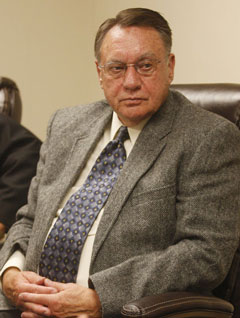Clement writes down Centennial project by $12.3 million in questionable accounting move
Delayed writedown may have misled investors; is new value still inflated?
Posted January 9, 2014
On November 11, Powertech officials released unaudited third quarter financial statements that include a stunning $12.3 million writedown of the dormant Centennial uranium project. The impairment charge occurred a full two years after Powertech essentially stopped spending on the project, calling into question the Canadian company's earlier accounting for the project. The massive writedown of 83% of the project's carrying cost coincides with the sale of 60% of the project to Hong Kong firm Azarga Resources Limited on August 1. Azarga purchased its interest in the project for $1.5 million, thus valuing the entire project at only $2.5 million. Immediately prior to the writedown, the project's balance sheet value was $14.8 million as certified by Powertech CEO Dick Clement.
 |
| Powertech CEO Dick Clement |
The fact that it took Clement two years to disclose that the project was impaired raises questions about the veracity of Powertech's financial reporting. For two years, investors have relied on Clement's assurance that the Centennial project was a $15 million asset. Two months ago, they learned it's only worth $2.5 million, long after events occurred that arguably caused the impairment.
Accounting rules related to mineral resources are complex, but there is compelling evidence that Powertech inappropriately delayed its writedown of the Centennial project. As a publicly-traded Canadian company, Powertech's financial statements must comply with International Financial Reporting Standards. The accounting for the Centennial project is governed by IFRS 6 Exploration for and Evaluation of Mineral Resources. Under IFRS 6, exploration and evaluation assets must be tested for impairment when facts and circumstances suggest that the carrying amount of the asset exceeds its recoverable amount. The recoverable amount is what Powertech could realize from selling the project, or the cash flows the project could generate if permitted and developed.
 |
| Azarga CEO Alex Molyneux |
IFRS 6 sets out several triggers for an impairment test. One of the indicators relevant to the Centennial project is if "substantive expenditure on further exploration for and evaluation of mineral resources in the specific area is neither budgeted nor planned." During the five years from 2006 through 2010, Powertech spent $17.1 million on the Centennial project, including purchasing mineral and surface rights, lease payments, drilling, testing, collecting environmental samples, mine planning, and preparing permit applications. In contrast, between January 2011 and September 2013, spending on the project dried up, totaling just over $300,000.
Powertech did write off $2.4 million in 2011 and 2012 as the company let options on properties lapse and sold off other properties. However, Powertech officials chose to wait over two years to take the huge $12.3 million charge that signaled the demise of the in-situ leaching project envisioned by the Canadian company. In the meantime, investors bought and sold Powertech stock and relied on Clement's repeated insistence that the asset was not impaired.
In an overview of IFRS 6 by accounting firm BDO International Limited, the authors note that another condition that may trigger impairment testing is a change in regulatory requirements. In 2008, the Colorado legislature passed and the governor signed House Bill 08-1161 in response to Powertech's proposed Centennial project. Among other provisions, the bill requires operators of in-situ leach uranium mines to restore the ground water to pre-mining water quality or to state water quality standards.
Powertech opposed the bill, even though company officials had promised northern Colorado landowners that the Centennial project would not contaminate local aquifers. Likewise, Powertech attempted to weaken related regulations during a subsequent two-year rulemaking process. After the rules were unanimously adopted by the Colorado Mined Land Reclamation Board in 2010, Powertech filed a lawsuit against the state to overturn the rules. Powertech's appeal to the uranium industry for support of its lawsuit fell flat, and after a half-hearted effort by its legal team, the lawsuit was dismissed by the court in July 2012.
After Powertech's lengthy but unsuccessful efforts to block Colorado's new regulation of in-situ leach uranium mining, the Canadian company still refused to test the project for impairment. Based on declining project expenditures and the enactment of House Bill 08-1161 and related regulations, the Centennial project likely became impaired sometime in 2011, and the impairment probably increased over the next two years.
Whether the new project valuation of $2.5 million is accurate is an open question. Powertech continues to sell off its land holdings; on December 16, Powertech sold a key 79-acre parcel to local real estate agent Shen Gruber. Powertech's sole justification for the $2.5 million valuation is its sale of 60% of the project to Azarga. It is debatable whether the sale is an arm's length transaction since Azarga is not only Powertech's largest shareholder but also its only source of financing.
Regarding the investment Powertech has made to permit the project, it is unlikely that Azarga will continue with Powertech's plans for in-situ leaching. The Hong Kong firm is heavily invested in the unproven uranium processing technology of ablation. Azarga's intentions for the Centennial project are not clear, and the Chinese company has revealed little about its plans. Azarga has invested in several exploration-stage uranium properties over the last year, and has been actively promoting ablation as a 'game-changing" technology for the industry.
Invented by a group of Casper, Wyoming residents, ablation utilizes a mechanical process to concentrate uranium ore prior to processing in a conventional uranium mill. While ablation can be used after open pit or underground uranium mining, its proponents are pushing the alternative ore extraction method of hydraulic borehole mining since it creates the slurry that is fed through the ablation machine.
If Azarga proposes ablation and borehole mining instead of in-situ leaching for Centennial, it will mark a new chapter for the controversial northern Colorado project. Any move by Azarga to resuscitate the project will undoubtedly reinvigorate the formidable opposition movement that forced Powertech to walk away from the project. And since ablation is not specifically addressed by federal and state radioactive materials regulations, efforts are underway to determine regulatory and licensing requirements for the uranium-concentrating process.
Powertech's writedown of the Centennial project is long overdue, based on the facts and circumstances surrounding the project. But even the current valuation is unsupported by Powertech. The Canadian company needs to explain to investors why it took so long to disclose the $12.3 million impairment, and why the project is currently worth $2.5 million.
JW
Powertech sells 60% of Centennial project to Hong Kong investment firm; inexperienced Chinese company becomes largest Powertech shareholder Powertech agrees to sell controlling interest in dormant Colorado uranium project to recently-formed Azarga Resources; 38-year-old Australian CEO Alex Molyneux makes deal to buy out Toronto hedge fund's shares, and is likely to propose new mining and processing methods for project Posted October 13, 2013